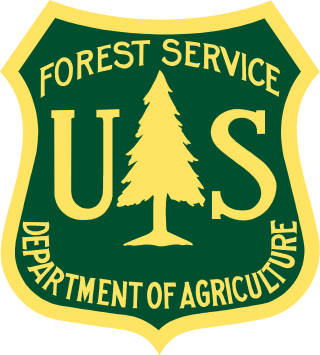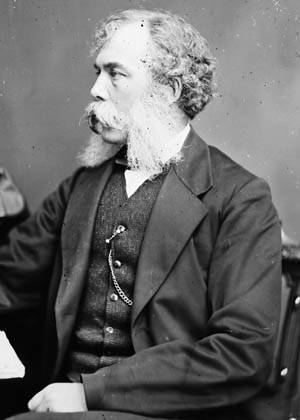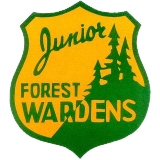Related Research Articles

Sherwood Forest is the remnants of an ancient royal forest in Nottinghamshire, England, having a historic association with the legend of Robin Hood.

The United States Forest Service (USFS) is an agency within the U.S. Department of Agriculture that administers the nation's 154 national forests and 20 national grasslands covering 193 million acres (780,000 km2) of land. The major divisions of the agency are the Chief's Office, National Forest System, State and Private Forestry, Business Operations, as well as Research and Development. The agency manages about 25% of federal lands and is the sole major national land management agency not part of the U.S. Department of the Interior.
The conservation movement, also known as nature conservation, is a political, environmental, and social movement that seeks to manage and protect natural resources, including animal, fungus, and plant species as well as their habitat for the future. Conservationists are concerned with leaving the environment in a better state than the condition they found it in. Evidence-based conservation seeks to use high quality scientific evidence to make conservation efforts more effective.
The Forestry Commission is a non-ministerial government department responsible for the management of publicly owned forests and the regulation of both public and private forestry in England.

Gifford Pinchot was an American forester and politician. He served as the fourth chief of the U.S. Division of Forestry, as the first head of the United States Forest Service, and as the 28th governor of Pennsylvania. He was a member of the Republican Party for most of his life, though he joined the Progressive Party for a brief period.

Archibald Stansfeld Belaney, commonly known as Grey Owl, was a popular writer, public speaker and conservationist. Born an Englishman, in the latter years of his life he passed as half-Indian, claiming he was the son of a Scottish man and an Apache woman. With books, articles and public appearances promoting wilderness conservation, he achieved fame in the 1930s. Shortly after his death in 1938, his real identity as the Englishman Archie Belaney was exposed. He has been called one of the first pretendians.

The great grey owl is a true owl, and is the world's largest species of owl by length. It is distributed across the Northern Hemisphere, and it is the only species in the genus Strix found in both Eastern and Western Hemispheres. In some areas it is also called the Phantom of the North, cinereous owl, spectral owl, Lapland owl, spruce owl, bearded owl, and sooty owl.

Sir Henri-Gustave Joly de Lotbinière, lawyer, businessman and politician served as the fourth premier of Quebec, a federal Cabinet minister, and the seventh Lieutenant Governor of British Columbia.

The Adirondack Park is a park in northeastern New York protecting the Adirondack Mountains. The park was established in 1892 for "the free use of all the people for their health and pleasure", and for watershed protection. At 6.1 million acres, it is the largest park in the contiguous United States.
The Canadian Parks and Wilderness Society (CPAWS) (French: la Société pour la nature et les parcs du Canada (SNAP)) was founded in 1963 to help protect Canada's wilderness.

The Great Bear Rainforest is a temperate rain forest on the Pacific coast of British Columbia, comprising 6.4 million hectares. It is part of the larger Pacific temperate rainforest ecoregion, which is the largest coastal temperate rainforest in the world.

The Minnesota Department of Natural Resources, or Minnesota DNR, is the agency of the U.S. state of Minnesota charged with conserving and managing the state's natural resources. The agency maintains areas such as state parks, state forests, recreational trails, and recreation areas as well as managing minerals, wildlife, and forestry throughout the state. The agency is divided into six divisions - Ecological & Water Resources, Enforcement, Fish & Wildlife, Forestry, Lands & Minerals, and Parks & Trails.
American Forests is a 501(c)(3) non-profit conservation organization, established in 1875, and dedicated to protecting and restoring healthy forest ecosystems. The current headquarters are in Washington, D.C.

The Sustainable Forestry Initiative (SFI) is a sustainability organization operating in the U.S. and Canada that works across four pillars: standards, conservation, community, and education. SFI was founded in 1994 by the American Forest & Paper Association (AF&PA). SFI is the world's largest single forest certification standard by area. SFI is headquartered in Ottawa and Washington, D.C.

Canada's boreal forest is a vast region comprising about one third of the circumpolar boreal forest that rings the Northern Hemisphere, mostly north of the 50th parallel. Other countries with boreal forest include Russia, which contains the majority; the United States in its northernmost state of Alaska; and the Scandinavian or Northern European countries. In Europe, the entire boreal forest is referred to as taiga, not just the northern fringe where it thins out near the tree line. The boreal region in Canada covers almost 60% of the country's land area. The Canadian boreal region spans the landscape from the most easterly part of the province of Newfoundland and Labrador to the border between the far northern Yukon and Alaska. The area is dominated by coniferous forests, particularly spruce, interspersed with vast wetlands, mostly bogs and fens. The boreal region of Canada includes eight ecozones. While the biodiversity of regions varies, each ecozone has a characteristic native flora and fauna.
Colonel William F. Fox was the Superintendent of Forests at the Adirondack Park in New York State.

The Junior Forest Wardens (JFW) is a Canadian volunteer-led organization focused on developing a wild lands conservation ethic in youth.

Forest conservation is the practice of planning and maintaining forested areas for the benefit and sustainability of future generations. Forest conservation involves the upkeep of the natural resources within a forest that are beneficial for both humans and the ecosystem. Forests provide wildlife with a suitable habitat for living which allows the ecosystem to be biodiverse and benefit other natural processes. Forests also filter groundwater and prevent runoff keeping water safe for human consumption. There are many types of forests to consider and various techniques to preserve them. Of the types of forests in the United States, they each face specific threats. But, there are various techniques to implement that will protect and preserve them.
Aroostook State Park is public recreation area within the southern municipal boundary of the city of Presque Isle in Aroostook County, Maine. The state park's 898 acres (363 ha) encompass Quaggy Jo Mountain and sit adjacent to Echo Lake. "Quaggy Jo" is an altered version of the mountain's Native American name, "Qua Qua Jo", which means "twin-peaked."
Pacific Forest Trust is an accredited non-profit conservation land trust that advances forest conservation and stewardship solutions. Its mission is to sustain America's forests for their public benefits of wood, water, wildlife, and people's wellbeing, in cooperation with landowners and communities.
References
- ↑ "CFA Timeline". CFA.
- ↑ "Search: Canadian Forestry Association. Forest and outdoors". Internet Archive. Retrieved June 27, 2019.
- ↑ "100 Years of Forest History: Grey Owl Bio". The Canadian Forestry Association. 2000. Archived from the original on 2005-04-05. Retrieved June 27, 2019.